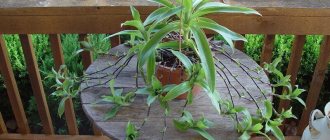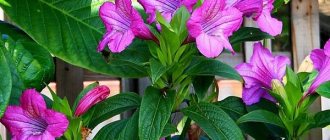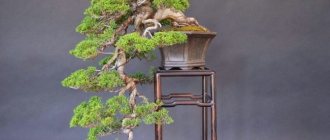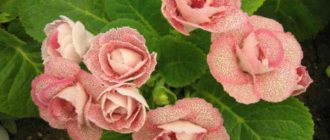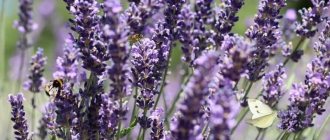Fuchsia is a houseplant that is sometimes called the "Elf Flower". For almost 300 years, these indoor flowers have been decorating the home and office spaces of flower gardeners around the world. In this article you will read about growing fuchsia and caring for it at home. The variety of color shades is simply mesmerizing. In everyday life, fuchsia is not capricious; even a novice gardener can grow it at home.
Care
Fuchsia has a huge number of hybrid forms with straight and pyramidal stems; there are ampelous and spreading varieties, hanging, climbing, in the form of bushes and bonsai. Fuchsia blooms profusely and for a long time with beautiful lantern flowers. We'll tell you how to care for indoor fuchsia at home:
Temperature
Comfortable temperature for growing fuchsia at home is 18 – 22 °C in summer and not higher than 18 °C in winter.
If the temperature is above or below these limits for a long time, the decorative properties of fuchsia may suffer. The buds will begin to fall off, the leaves will become smaller and lighter. The plant will slow down its development. There will be a risk of infection by diseases and pests. If the temperature during the active growing season of fuchsia drops below comfortable, the same effect will occur. The plant orients itself based on the ambient temperature. When it is warm and light, the flower actively develops and blooms profusely, usually from spring to autumn. At the end of autumn and winter, when it becomes cooler and there is less sunlight, the development of the fuchsia flower stops, buds stop forming - the fuchsia is preparing to rest.
Location
It is better to place flowerpots with fuchsia on the windowsills of the eastern and northern sides of the room. Even here, the flower must be protected, if necessary, from direct sunlight with the help of blinds or curtains. On north-facing windows in the spring, fuchsia may not have enough lighting. You will have to provide the bushes with illumination using a phyto lamp or a fluorescent lamp for up to 12 hours a day.
On southern windows, especially in the summer, fuchsia will be too hot. It is better at this time to take the flowerpot with a flower into the garden under the trees or onto the balcony, where the sun's rays will illuminate the fuchsia only early in the morning. At noon and until evening, fuchsia feels best in partial shade. During flowering, it is advisable not to move the flower from place to place and not to turn different sides towards the light. Fuchsia doesn't like this, and can simply drop all its buds.
Watering
Proper watering is the most important component of caring for blooming fuchsias. Many factors influence the frequency and quantity of watering a flower:
- Pot location
- Fuchsia variety
- Her growth stage
- Soil composition
- Pot size and type
- Weather
Without additional nutrition, fuchsia can survive for quite a long time, but without water it cannot. Fuchsia needs to be watered regularly. Make sure that the soil is well saturated with moisture each time. The next watering should be no earlier than the top layer of soil from the previous watering has dried out. Excess water from the pan must be drained to prevent moisture stagnation in the roots of the plant.
A flowering plant has a great need for moisture. In the summer, you will have to water frequently and regularly - every 3-4 days, and sometimes more often.
If the fuchsia looks drooping and the soil in the pot is wet, the problem is not watering. Perhaps your beauty has overheated.
In autumn, watering is gradually reduced to once a week, and in winter, watering is done no more than once or twice a month.
Feeding
Fuchsia needs to be fed regularly, once every two weeks. This is especially important during the active growing season, from April until autumn. For feeding, complex fertilizers for ornamental flowering plants are used. Watering with liquid fertilizers must be done on moist soil. Fertilizing helps fuchsia grow green mass and form countless buds. You can also use foliar feeding of fuchsia on the back of the leaves.
During winter dormancy, fuchsia is not fed.
Young, newly planted fuchsia bushes do not need to be fed, as they are planted in well-prepared soil filled with all the necessary microelements and organic matter. The same rule applies when transplanting a plant into a larger pot with new nutrient soil. Feeding should be resumed about a month after transplantation.
Humidity and spraying
For fuchsia, air humidity is comfortable within the range of 50 – 60%. Too dry indoor air will cause fuchsia leaves and buds to yellow and wilt. You can increase the humidity of the surrounding air using wide containers of water placed next to the fuchsia. You can also place the flower pot in a tray with wet pebbles or expanded clay.
On hot summer days, fuchsia will be saved from the heat by regular spraying with settled water at room temperature in the morning and evening hours. It would be good to take the fuchsia out into the fresh air in the garden, in the shade under the trees, or at least on the balcony, where the sun's rays reach only in the morning. But we must remember that this must be done carefully - after all, fuchsia does not like being moved from one place to another during flowering.
When spraying, try not to get the spray on the flowers.
How to grow fuchsia in spring
In the spring after wintering, you need to transplant the flower into a new pot or clean it and plant it in fertile soil. Trim off excess and dry branches. Take the plant out of the basement and place it on the windowsill in a room where there is sun, and wait for new shoots.
Fuchsia growing and care in the garden, in open ground
In dry air, the bush should be sprayed with soft, warm water. This helps the plant to wake up and awaken the buds very well.
Important! To feed, dissolve 1 g of magnesium sulfate in 1 liter of water.
Fuchsia should be properly kept in the sun and provided with proper care. This is required so that the shoots begin to develop evenly.
After the shoots grow in several rows, pinching is required to make the crown fuller.
Trimming
When warm weather arrives, the flower can be taken outside. First for a day, and then gradually increase the time spent on the street.
How to feed in spring
In spring, fuchsia needs to be fed with fertilizers with a high nitrogen content for the growth of green mass. Bait should be applied in moderation. If you overfeed, this can lead to burns of the roots or reduction of flowers and loss of presentable appearance. The flower should be properly fertilized once every 7-10 days.
Landing
It is impossible to plant fuchsia or, especially, a cutting immediately into a large pot. It is necessary to increase the size of the pot gradually. At first, the pot should not be more than 9 cm in diameter. As the roots entwine the entire lump of earth and the need arises to replant the plant, you can prepare a slightly larger pot. Place a good layer of expanded clay or other drainage material on the bottom. Add a layer of soil and plant the prepared bush or cutting.
This may be interesting: Medicinal and other beneficial properties of Muraya
The pot must be well filled with soil to prevent voids between the roots and the walls of the pot. To do this, gently shake the pot and tap on its walls, but under no circumstances compact it with your hands. For fuchsia to grow, porous soil is as important as good drainage.
Forms and varieties
In home floriculture, hybrid fuchsia is most often grown - a group that includes more than two thousand varieties of delightful shades, each of which deserves the attention of a gardener and will wonderfully decorate a room, balcony or veranda.
According to the shape of the bush and type of growth, bush, ampelous and semi-ampelic types are distinguished. This division is quite arbitrary, since the appearance largely depends on the formation and growing conditions.
Bush fuchsias (erect)
Bush fuchsias (erect)
The most common form, which is characterized by erect, frequent branches from 35 to 90 cm in length. The oblong-oval leaves with serrations are arranged oppositely on long petioles. The flowers are collected in loose racemes or solitary, located in the axils of the leaves and hang down like luminous lanterns.
It is the bush type that is most often used to create standard forms, breaking off all the side shoots and allowing the fuchsia to grow only at the top or, for greater effect, one of the ampelous varieties is grafted onto the standard.
How to grow a rose in the form of a standard, read the article “Standard roses - planting.”
Ampelous fuchsias
Ampelous fuchsias
The long flexible stems of ampelous fuchsia fall freely, which makes it possible to plant plants in pots and decorate verandas and terraces with them. The flowers are medium or very large, of various shades, double, semi-double and bicolor. For more luxuriant flowering, several cuttings are planted in one pot.
Ampelous forms, grafted onto a standard, make it possible to obtain attractive tall trees with a weeping crown. Hanging fuchsias develop well in partial shade; they do not like direct sunlight and drafts, which is taken into account when placing them.
Semi-ampel fuchsias
Semi-ampel fuchsias
Semi-ampeled varieties at the initial stage look like typical bush forms with erect shoots, which droop over time, hanging under the load of heavy flowers, and the bush takes on an ampelous appearance. Lush flowers can break off shoots, so they are tied to supports. The appearance and development of such fuchsia largely depends not only on the variety, but also on the formation, and some species can be successfully grown as trees.
Transfer
Taking fuchsia out of an old pot
Fuchsia is a fast-growing plant. Therefore, it must be regularly replanted into a pot of suitable size, which is 3–4 cm larger than before. It is better to do this every spring, when the flower begins to awaken and grow.
It’s better to take a ceramic pot so that it protects the plant’s root system from overheating in the summer heat. Don't forget about drainage. 2 - 3 cm of expanded clay or pebbles at the bottom of the pot will protect the roots of the plant from rotting. As a substrate, it is better to take a purchased soil mixture for flowering indoor plants.
You can also prepare the soil for replanting fuchsia yourself. To do this, mix leaf soil, turf soil, humus, peat and coarse river sand in equal parts. Replant using the transfer method: pour a little prepared soil into the pot on the drainage layer, then carefully remove the fuchsia from the old pot and place it in a new pot together with a lump of earth. Fill the voids on the sides with soil mixture.
After transplanting, place the fuchsia on a shelf with diffused lighting. Trim its stems to one-third of the length. Spray the leaves and water the substrate with settled water until excess water appears in the pan. After a few minutes, drain excess moisture from the pan.
After transplantation, no additional feeding is needed for a month!
Now wait a couple of months - abundant fuchsia blooms are guaranteed!
How to resuscitate?
You can save fuchsia in cases of overflow, disease infection or pest invasion by performing the following manipulations:
- Place the flower in the shade away from other plants.
- Determine the cause of poor health.
- In case of illness or when insects appear, treat with fungicides and insecticides.
- If the plant has been “flooded,” remove excess moisture by placing the pot on paper or in sand.
- Replant fuchsia.
- Cut the cutting and plant it in a new pot if the fuchsia cannot be brought back to life.
Common mistakes:
- Too frequent and abundant watering. Fuchsia loves humidity, but does not like water to stagnate in the pot. Water the plant only when the soil dries out. And don't forget about drainage in the pot.
- Lack of light. Fuchsia is a light-loving plant, and in the shade it begins to fade.
- The pinching was done at the wrong time. The bush needs to be formed in the first half of spring. If you are late with pinching, it is better to postpone it until next year.
- Lack of fertilizing. Insufficient amounts of nutrients negatively affect the growth and flowering of fuchsia.
- Drying out. This is the other extreme. Many novice gardeners, afraid to “flood” fuchsia, water it too rarely. And this also negatively affects the plant.
- Overheat. In summer, fuchsia should be protected from direct sunlight. To do this, a pot with a plant is either placed deep in the room, or the window is shaded with paper.
- Moving to another location during the growing season. You can move the fuchsia from its place only before wintering, when the pot is transferred to a cool place. The rest of the time, the plant must remain in place, otherwise it will simply shed its foliage and will not bloom.
Trimming and pinching
Fuchsia flowers appear on young shoots. To increase the number of such shoots, the plant should be regularly pruned, and young shoots should be pinched. Pinching is a very effective method of making fuchsia bloom more abundantly. Using pinches, the desired shape is formed, giving the crown the appearance of a ball, bush or miniature bonsai tree.
Fuchsia, depending on the variety, grows to a height of three meters or more. It is difficult and impractical to grow such a giant indoors. If you pinch the plant in time, it will form into a strong and beautiful bush.
Indoor fuchsia should be trimmed twice a year: in the fall, at the end of the mass flowering of the flower (October), and in the winter (early January).
Fuchsia in the form of a tree
During the first, autumn, pruning, you will remove all faded fuchsia branches at a height of 2 cm from the dormant buds. Carefully inspect each branch for pests, remove excess seed pods and outdated flower stalks. If insect pests are found, cut off severely damaged parts of the flower and treat the entire plant with an insecticide.
Do the second pruning in early January to finalize the crown of the plant. If the fuchsia overwintered in the basement or garage, the plant has already been pruned in the fall. In spring, all that remains is to remove dry shoots and leaves from it.
If the plant has been in the room all winter, it must be trimmed. Use clean pruning shears or garden shears to remove any long, thin shoots as they will be of little use. They will not bloom luxuriantly, and your bush will not become more beautiful from them.
Fuchsia bonsai
If the plant is periodically pruned, it will grow in width instead of height. It is also better to cut off woody old shoots, since they consume nutrients and have almost no flowers. All flowers bloom only on young shoots. A strong and beautiful bush will soon form.
If you decide to form a bonsai from fuchsia, then leave only one shoot or, conversely, several such shoots that can be twisted together so that they act as the trunk of your tree. The tops must be pinched to form a lush crown of the bonsai.
What is the best way to pinch fuchsia so as not to harm its beauty and decorativeness?
If you want to form a tree from fuchsia, pinching should be done in winter, when the life processes of the plant slow down. Remove excess shoots, leave a few on the central stem. Look what happened in the spring. If the crown of the flower is not yet formed as you would like, prune it again in the spring.
You can trim the plant right to the stump. In this case, the fuchsia will sleep longer and bloom later, but a wide bush will form.
Fuchsia in bush form
If the shoots are cut back by only a third, the fuchsia will turn into a tree and can take up a lot of space.
The shoots that grow in place of the old branches are pinched a couple of times as they grow. Fuchsia will then turn into a lush beauty and will delight you with abundant flowering.
If young branches are pinched above the third pair of leaves, tillering will increase. To enhance the effect of tillering, the regrown branches need to be pinched again, but now near the second pair of leaves.
You decide for yourself what you will grow from fuchsia - a bush or a tree!
Keep in mind that before fuchsia blooms, two months pass for the formation and development of buds. Fuchsias with small simple flowers bloom earlier than plants with giant inflorescences and large double flowers.
Types of home fuchsia with photos and names
Fuchsia graceful
Fuchsia graceful is a small shrub up to 1 meter in size. The flowers are drooping, bell-shaped, with a pronounced reddish tint. The calyx of the flower is formed by four concave petals, of a reddish hue. The corolla is much shorter in length than the calyx. The color is usually a bright purple hue.
Fuchsia Magellanica
The shrub reaches a height of five meters. However, as a rule, there are specimens up to 2-3 meters. The Magellan species is native to South America, particularly Argentina and Chile. The leaves are elongated, reaching a length of up to 5 cm. The veins are purple, the tips of the leaves are jagged. The flowers grow solitary, often collected in groups of 4-5, drooping. Oblong in shape, reminiscent of a funnel, with a slight reddish tint. Petals at the base with a slight blue tint.
Fuchsia brilliant
Evergreen shrub, up to 1-2 meters high. Habitat: Mexico. The leaves are large, oblong in shape. They reach a length of up to 20 cm, a width of 10-15 cm. The corolla is an elongated narrow tube up to 10 cm long. Inflorescences are racemose. Blooms profusely from June to August.
Fuchsia boliviana
Branched shrub, evergreen. Homeland - South America. Often found in Ecuador, Guatemala, Bolivia. Maximum height 1-1.2 meters. The ovoid leaves reach 15 cm in length. The flowers are tube-shaped, large, bright red.
Care for fuchsia in winter
Fuchsia is a perennial plant. It cannot grow and bloom from year to year without interruption. To replenish vitality, she needs rest - wintering. But home care in winter is just as necessary as in other seasons. Usually in winter, fuchsia is at rest. From a warm, bright room it must be moved to a dark and cool one. For example, in a basement or garage with a temperature of 5 to 15°C. Fuchsia does not need lighting in winter. The indoor flower should be watered a couple of times a month - it does not like very dry soil even during hibernation. Let him stay there until the end of January. Don't worry about the leaves falling off - you will still remove almost all the shoots. By spring, new, young ones will grow.
This may be interesting: How to care for indoor Gerbera
If you have a glazed and insulated balcony, where the temperature does not drop to sub-zero levels, a fuchsia pot can overwinter on the balcony. Only here she will not be able to fully rest, since the processes of her development will continue in the light. The flower will need to be looked after and watered regularly, but not abundantly. Dry leaves and shoots need to be cut off so as not to provoke the development of diseases. In winter, a weakened plant may attract the attention of insect pests. It should be treated with an insecticide at least once during the autumn-winter season.
If your fuchsia is kept indoors in winter, it will survive, but by the end of winter it will lose all its attractiveness and take on a deplorable appearance. In this case, cut the plant to 2/3 of its length and remove all dried branches. Move the flower away from heating appliances - on a table or shelf. Monitor the humidity of the surrounding air. If necessary, and in winter it is definitely necessary, increase the humidity in the room by spraying the plant with warm water. Ventilate the room as often as possible. Place wide containers filled with water next to the flower. Regularly, but not too much, water the soil with settled water, sometimes adding potassium permanganate. Once a month, feed the flower with complex fertilizer for flowering plants. If these conditions are met, your fuchsia will come to life and new shoots will appear. It can even bloom in winter. But don’t expect that in the spring it will quickly restore its shape and delight you with unprecedented flowering.
Pests, diseases, and methods of combating them
Fuchsia is resistant to many diseases and, with proper care, does not give cause for alarm. The most common diseases include the following:
Rust. The fungal disease affects the lower part of the leaf blade and is expressed in the appearance of brown spots on it. At the first signs of rust, the affected leaves are removed and all garden tools are disinfected. The flower itself is sprayed with Bordeaux mixture 2-3 times with an interval of 4-5 days.
Chlorosis. The disease is provoked by improper watering and lack of magnesium. The main symptom is yellowing of the leaves. To solve the problem, you need to restore the normal watering regime and feed the flower with fertilizer with magnesium.
Harmful insects also attack the plant. Most often, whitefly infests fuchsia. A small fly lays larvae; they can be seen on the back of the leaf blade. Spraying the flower with fungicides (Actellik, Thiamethoxam) helps to get rid of them.
Root rot
The disease occurs when there is excessive watering, when water is not removed from the trays and the soil is constantly in a wet state. The roots do not have time to absorb such an amount of liquid and rot. To get rid of the disease, you need to select a plant from the pot and remove all rotten roots. Then the flower is immersed in clean water and waiting for new healthy roots to appear.
Change your appearance
Most changes in the appearance of fuchsia are directly related to poor care:
- Excess moisture in winter leads to the appearance of yellow stripes and brown spots on the leaves of the flower.
- The leaves are “decorated” with a strange dew in which white powdery inclusions float. This means the air is too humid.
- Yellow stains appear in the veins of the leaves. This is how the plant signals that it lacks manganese. Add fertilizers containing this element to your fertilizing products.
- Leaves turn yellow – nitrogen and magnesium deficiency. It is necessary to feed the flower with appropriate fertilizers.
People often ask why fuchsia leaves curl? The answer is very simple - the plant does not have enough light during the day. If you put the plant in the light and the leaves still curl, carefully inspect them. If they twist up, it means the flower lacks zinc, downwards means there is a deficiency of molybdenum.
Having studied in detail how to care for the inhabitant of your garden, you can avoid the problems described, and your favorite flower will always look beautiful.
Another problem that inexperienced fuchsia lovers face is failure to bloom. Why doesn't fuchsia bloom? It happens that the buds started and then fell off. Look for the cause in unbalanced watering. Perhaps you accidentally moved the flowerpot, then it will also stop blooming.
Propagation by cuttings
Rooting cuttings in water is the main and most successful way to propagate fuchsia. The best time for cuttings is spring. Choose a young shoot from a fuchsia bush. The length of the cutting depends directly on the fuchsia variety. Usually they take from 10 to 20 cm. The point is that over time, the fuchsia shoots harden a little. If you take an old shoot for propagation, it will also take root, but this process will take longer. The young shoot will take root faster and will grow more actively in the future. Remove the leaves at the bottom of the shoot so that none of them comes into contact with the liquid in the container prepared for rooting. Also cut off large leaves completely or in half. The cutting does not yet have its own roots, and the leaves will draw all the moisture from it, preventing the root system from forming. Place the cutting in a jar of settled water and cover the top with a thick translucent bag. In 5 to 10 days, roots should appear. After a couple of weeks, the cutting can be planted in a prepared (preferably ceramic) pot with a nutrient mixture and drainage at the bottom. The size of the pot should be no more than 9 cm in height.
Rooting cuttings in water
If you decide to propagate fuchsia in the summer, keep in mind that it loves coolness and humidity. At high temperatures, a cutting placed in water may rot without ever sprouting roots. We advise you to root the cuttings in a room with air conditioning or a split system.
In autumn, fuchsia prepares for a dormant period. All life support processes of the plant slow down. So from September to January it is better not to propagate using cuttings.
The second method involves planting the cuttings immediately in a prepared substrate - in a peat tablet, in perlite, vermiculite or sphagnum. Be sure to place the planting material in a greenhouse or container with a lid to create a greenhouse effect, since such rooting requires high air humidity. As soon as the shoots take root, the greenhouse is opened slightly and the seedling is gradually accustomed to indoor conditions.
A sudden change in climate can cause the shoot to lose its leaves and die.
Autumn harvesting of cuttings
Autumn harvesting of cuttings is the best way to preserve fuchsia during the winter. In early autumn, take several cuttings from an adult healthy bush. They are suitable for propagating fuchsia. We take several cuttings as a safety net in case some of them do not survive the winter.
Cuttings need to be taken 15 - 20 cm in length, depending on the variety. They are stored in pots with soil in cool places, such as garages and basements. You can also save fuchsia cuttings on the bottom shelf of the refrigerator, in a bag of sawdust. Closer to spring, they are taken out, treated with a solution of potassium permanganate and placed in water for rooting. (see above)
Description of Fuchsia.
There are a large number of fuchsia varieties.
Fuchsia leaves are bright green, elongated oval in shape and pointed at the end. The stem is light, and the leaf petioles have a reddish tint. In most varieties they are arranged in pairs. There are a huge number of Fuchsia varieties known. Therefore, Fuchsia flower stalks vary depending on the specific variety. They can be of different shapes and different shades, from white to blue purple. Flowers are single, semi-double, double and densely double. And they consist of sepals, a skirt and graceful stamens, as a result of which they look like both bells and tiny ballerinas.
Propagation by leaves
If it is not possible to cut a cutting suitable for propagation from a fuchsia bush, you can use fuchsia leaves for this purpose. Cut off a large healthy leaf along with the cutting and bury it a centimeter into wet perlite. In greenhouse conditions, with daily spraying, high humidity and constant temperature, a miniature rosette of leaves will begin to develop at the base of the petiole. When it is strong enough, separate it from the leaf and plant it in a separate pot with a nutrient mixture (any soil mixture for flowering plants will do).
How to choose a plant in a store?
Specialized retail outlets have a large selection of such colors. Each species is different in beauty, so lovers of indoor plants have a rather difficult time when purchasing.
To decide on the required fuchsia variety, you need to know exactly what parameters are important to you:
- bud color, ideal for your interior;
- future location of the flower ;
- the size of the flowerpot and the entire crown of the plant;
- the volume of area occupied by the flower;
- more acceptable conditions of detention.
Advice! It is very important to decide exactly how you will form the crown of your indoor plant.
Be sure to take this point into account when choosing. To beautifully decorate a flowerpot, fuchsia can be grown in several ways :
- Ampelous (see more about this type). In this case, flexible, fairly long shoots will allow you to grow an armful of flowers from them in a hanging flowerpot .
- Bush or standard . Depending on the chosen variety, you will be able to grow either a bush or a home flower on a trunk. Such forms of decorative fuchsia can only be created from upright, strong shoots.
- Semi-ampel (shown in the photo). Such varieties first grow in the form of bushes, and later, as the flowers bloom, they bend and gently hang outward over the edges of the flowerpot .
Propagation by seeds
Fuchsia seeds
Growing from seeds at home is rarely used in the case of fuchsia. Only experienced flower growers or breeders can do this. Sometimes, for the sake of experiment, amateur flower growers also try to collect seeds from a plant and grow their own fuchsia specimen from them. If you want to try it too, we'll tell you how to do it.
The procedure for obtaining fuchsia seeds is quite labor-intensive, but interesting.
This may be interesting: Anthurium: diseases and other problems of growing at home
To begin with, exclude the possibility of the plant self-pollinating or pollinating it by random insects. To do this, remove the anthers from a selected flower that has not yet bloomed. Then, on the stigma of the pistil, on the stamens, apply pollen from the variety of fuchsia that you want to grow. Now carefully put a fabric cover on the bud or wrap it with a piece of gauze and secure it with thread. In this form, the flower will stand for several weeks until the fruit ripens.
In order not to spoil your work, it is better not to touch the flower while the fruit is ripening!
When the fruit is ready, remove it from the stem with tweezers. Carefully cut and remove the seeds. Dry the seeds for several days before planting them in the ground or storing them. It is better to plant seeds in tall containers with a lid. You need to sow seeds on a damp surface of the substrate (peat plus coarse sand). Don't cover the seeds, just press them down a little with your fingers. Close the lid and place the container in a well-lit, warm place for germination. But not in direct sunlight! It is advisable to sow fuchsia in early spring. The lack of lighting must be compensated with the help of additional lighting with fluorescent lamps. The seed germination temperature should be maintained between 18 – 22 °C. Don't forget to ventilate your greenhouse. If necessary, moisten the soil in the container with settled water using a fine spray bottle. Shoots will appear in a couple of weeks. Now the lid can be opened more often and for longer - let the young bushes get used to indoor conditions. Make sure that the substrate does not dry out, the lighting is diffused and for at least 12 hours. per day, the temperature should be comfortable.
After one and a half to two months, young fuchsia bushes need to be pruned. Before replanting the plants, the substrate in the container is well watered. The seedlings are taken out along with the soil from the root system, one at a time, and planted in a separate pot. Water generously. The soil can be used purchased for flowering plants, or you can prepare it yourself from equal parts of turf and leaf soil, humus, peat and coarse sand. Remove the pots with young plants from sunlight and into the shade - let them gradually get used to the new conditions. After a couple of weeks, pots with young fuchsias can be placed in a permanent place prepared for them. Further care consists of regular watering, good lighting, and a comfortable temperature. After a month, not earlier, you can begin to gradually feed them with complex fertilizers for flowering plants. No more than once every 2 weeks. Don't forget to shape the crown of your flower. If you want it to be full, strong and not too tall, pinch off the top.
Signs and superstitions
Fuchsia is a common flower. Once in the house, it becomes its decoration. She is credited with magical properties. The plant is not too picky, but requires special care.
It is useful to have this kind of plant for creative people. It gives them inspiration and fills them with energy. It grows and emits special energy.
In a house where representatives of several generations live, mutual understanding and prosperity will reign. The love that a person gives to this flower multiplies and returns to him in the form of an increase in inner beauty and charm.
In addition to all the positive qualities, fuchsia is considered a flower whose owner in most cases is a single woman. Many gardeners call fuchsia a widow's flower.
Diseases
Fuchsia is rarely affected by diseases and insect pests. The main problems arise from careless plant care. Let us introduce you to some of the problems that arise when growing fuchsia at home.
Fuchsia has dropped its buds. Probable reasons:
- insufficient or excessive watering;
- moving a pot with a flowering plant to a new place;
- insufficient lighting;
- air temperature is too high;
- lack of nutrition in the soil.
Why does fuchsia shed its leaves? Probable reasons:
- indoor air is too dry;
- high air temperature;
- lack of moisture in the soil;
- lack of nutrition in the soil.
The fuchsia leaves have turned yellow. Probable reasons:
- waterlogging of the soil (water the flower correctly, excess water from the pan must be drained. During the dormant period, reduce watering to a minimum).
Dark spots and small drops of dew appeared on the fuchsia leaves. Probable reasons:
- The air humidity in the room is too high (it is necessary to reduce the humidity, ventilate the room more often, spray the fuchsia with special preparations).
Fuchsia does not bloom. The reasons may be the following:
- unfavorable conditions during hibernation;
- late circumcision or untimely pinching of fuchsia;
- the plant is in direct sunlight;
- little light (the shoots will stretch out, will be thin and frail, the buds will be weak or not formed at all).
- the pot is too large for the flower (fuchsia will bloom when its roots completely entwine the entire soil in the pot. If the flower is still small and the pot is too large, most likely you will not see flowers this year);
- the soil in the pot is poor and too light (such soil quickly becomes compacted from watering, there are few useful elements in it. The root system is located at the edges of the pot, cannot weave the entire earthen ball in the center and suffers greatly from this);
- the soil is too heavy, the roots develop poorly or stop developing altogether (the plant does not receive moisture and nutrition, the soil turns sour, the roots rot);
- the flower was overfed with nitrogen fertilizers (the green mass will begin to increase to the detriment of flowering. Until the fuchsia uses up the entire excess supply of nitrogen fertilizers, it will not bloom).
Features of growing at home. Briefly
Decorative fuchsia indoors requires careful care. In indoor conditions it is rarely possible to grow a flower more than 30-50 cm in height. The plant is considered especially attractive during the flowering period. Content criteria:
| Temperature | In summer the temperature is considered to be 18-25 degrees, in winter around 5-10 degrees. |
| Air humidity | A high percentage of moisture should be maintained and sprayed daily. |
| Lighting | Loves bright diffused light. Avoid exposing the leaves to direct sunlight, which can cause burns to the plant. |
| Watering | Abundant, from the pallet. In winter, reduce and avoid wetting the foliage. |
| Priming | Slightly acidic soil with good drainage is suitable. |
| Feeding and fertilizer | During the flowering period (spring-autumn), fertilize with mineral fertilizers every 2 weeks. Do not fertilize the soil in winter. |
| Transfer | This is done as the roots fill the pot, in early spring. The plant is perennial and requires periodic renewal. |
| Reproduction | Two methods are used - seeds and cuttings. |
| Features of cultivation | In summer it is necessary to take the pot out into the open air and avoid drafts. In winter, growth slows down, buds are pinched, and watering is reduced. |
Pests
Whitefly
In hot, dry weather, insect pests can settle on fuchsia bushes. The most common parasites for this flower are whiteflies and spider mites. You will see whiteflies if you shake your bush - a lot of white tiny moths will fly in all directions. Larvae and eggs of the pest will remain on the leaves. This is a very dangerous pest. It multiplies quickly and is difficult to hatch. You can identify a spider mite by the cobwebs that appear on the undersides of the leaves.
If this problem arises, you will have to solve it with the help of folk remedies or chemicals and insecticides. It is necessary to spray the affected plants several times, at intervals of 5–7 days, until the fuchsia is completely free of sucking insects.
Monitor your plants, regularly inspect them for diseases and pests, and take action in a timely manner.
Video: caring for fuchsia
Soil requirements
Fuchsia semi-ampelous variety La Fiesta
Fuchsia loves porous, nutritious soils that absorb moisture well and allow air to pass through, with a neutral or slightly acidic reaction. To make your own high-quality soil mixture, one of the following recipes is suitable.
Option 1:
- 3 parts leaf soil,
- 2 parts peat
- 1 part sand.
Option 2:
- 1 part of turf land,
- 2 parts leaf soil,
- 1 part humus,
- 1 part sand.
If grown in low-nutrient soil, especially in the presence of an alkaline reaction, the plant will be affected by rot, the leaves will become pale in color, flowering will weaken and may completely drop buds . If possible, soil is purchased from specialized stores.
Watering
Fuchsia should be watered with settled water. She shouldn't be cold. It is best to use water at room temperature.
Watering is carried out differently at different times of the year. In the warm season, the plant is watered as the top layer of soil dries. In mid-autumn, the quantity and volume of watering is reduced. By the beginning of winter, fuchsia needs to be watered very rarely.
In winter, the amount of watering depends on the conditions of the plant. If the room temperature is less than 10 degrees, then the plant needs to be moistened very rarely. If it is warmer, then the frequency of watering should be the same as in late autumn.
IMPORTANT!
Fuchsia does not tolerate heat and dryness very well. Therefore, in the summer months you need to spray the plant. This should be done in the shade in the morning or evening. Also shade the flower and ventilate the room.
Problems during cultivation
If the gardener does not care properly when growing this ornamental plant, the following problems may arise:
- Falling buds. In this case, you need to lower the temperature in the room, adjust the frequency of watering, feed the plant and provide it with sufficient lighting.
- Yellowing of foliage. This situation occurs when overwatering.
- Falling leaves. Dry indoor air, elevated temperatures and lack of fertilizers lead to this problem.
- Lack of flowering. In order for the plant to bloom at the right time, it must be pruned in a timely manner and provided with sufficient lighting. It is also recommended not to overfeed fuchsia with nitrogen fertilizers, as they negatively affect flowering.
- The appearance of dark spots on the leaves. In this case, it is recommended to reduce the humidity and ventilate the room.
